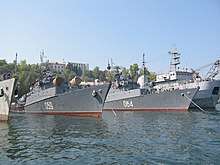Sevastopol Naval Base
The Sevastopol Naval Base (Russian: Севастопольская военно-морская база; Ukrainian: Севастопольська військово-морська база) is a naval base located in Sevastopol, on disputed Crimean peninsula. It is a base of the Russian Navy and the main base of the Black Sea Fleet.
| Sevastopol Naval Base | |
|---|---|
Севастопольская военно-морская база Севастопольська військово-морська база | |
| Sevastopol, Crimea (Disputed between Russia and Ukraine[1]). | |
 Map of the Sevastopol Bay | |
.svg.png) Sevastopol Naval Base | |
| Coordinates | 44°36′28″N 33°31′48″E |
| Type | Naval base |
| Site information | |
| Owner | Disputed: |
| Operator | |
| Controlled by | |
| Condition | Operational |
| Site history | |
| Built | 1772–1783 |
| Built by | |
| In use | 1783–present |
| Garrison information | |
| Garrison | |
| Occupants | |
Geography
The Sevastopol Naval Base is completely located within the administrative territory of Sevastopol. It has several berths located in several bays of Sevastopol – Severnaya (Russian: Северная бухта; Ukrainian: Північна бухта), Yuzhnaya (Russian: Южная бухта; Ukrainian: Південна бухта), Karantinnaya (Russian: Карантинная бухта; Ukrainian: Карантинна бухта) and others.
History
The construction of the port started in 1772, while the Russo-Turkish War (1768–1774), was still ongoing, and was finished in 1783, following the annexation of Crimea by the Russian Empire. On 13 May 1783, the first eleven ships of the Imperial Russian Navy reached the Sevastopol Bay.[2]
During the Crimean War (1853–1856), all large ships were scuttled in the entrance to the bay in 1854 to prevent the entry of enemy ships into the bay. The city defended itself for 349 days against the allied armies of France, United Kingdom, Ottoman Empire and Piedmont-Sardinia. Eventually, the Russians had to abandon Sevastopol on 9 September 1855.[2]
During World War I, the Imperial German Army occupied Sevastopol on 1 May 1918 despite the ongoing negotiations to reach the Treaty of Brest-Litovsk. After further negotiations, the most important ships of the Black Sea Fleet in Tsemes Bay in front of Novorossiysk were sunk by their crews.[2]
During World War II, the Black Sea Fleet of the Soviet Navy was able to fend off the first air attack by the Nazi German Luftwaffe. However, after the city defended itself for 250 days, Sevastopol fell to the Germans on 4 July 1942.[2]
After the dissolution of the Soviet Union at the end of 1991, the claim of the now Russian Navy for use of the naval base was initially lost (since Crimea was transferred to the Ukrainian SSR in 1954, the base was on the soil of the new post-Soviet state Ukraine). From then on, Russia paid an annual lease to Ukraine for the use of the base until 2014, as regulated by the Partition Treaty on the Black Sea Fleet and the Kharkiv Pact.[3][4] Since the annexation of Crimea by the Russian Federation in 2014, the naval base is again under Russian control.[5]
Gallery
 The first map of the Akhtiar (Sevastopol) Bay, created by navigator Ivan Baturin and his team, 1773.
The first map of the Akhtiar (Sevastopol) Bay, created by navigator Ivan Baturin and his team, 1773. The Russian Squadron on the Sebastopol Roads (1846), by Ivan Aivazovsky.
The Russian Squadron on the Sebastopol Roads (1846), by Ivan Aivazovsky. Map of Sevastopol, 1904.
Map of Sevastopol, 1904. Color view of part of the port, 1905.
Color view of part of the port, 1905. Aerial view of the port, August 1918.
Aerial view of the port, August 1918. Russian ships in Sevastopol, 2005.
Russian ships in Sevastopol, 2005. Russian ships in Sevastopol, 2008.
Russian ships in Sevastopol, 2008. Russian ships in Sevastopol, 2015.
Russian ships in Sevastopol, 2015.
See also
- Port of Sevastopol
- Naval museum complex Balaklava, former submarine pen 10 km south of Sevastopol in Balaklava Bay
- List of Russian military bases abroad
References
- This place is located on the Crimean peninsula, most of which is the subject of a territorial dispute between Russia and Ukraine. According to the political division of Russia, there are federal subjects of the Russian Federation (the Republic of Crimea and the federal city of Sevastopol) located on the peninsula. According to the administrative-territorial division of Ukraine, there are the Ukrainian divisions (the Autonomous Republic of Crimea and the city with special status of Sevastopol) located on the peninsula.
- "Flottenstützpunkt Sewastopol" (in German). Retrieved 26 November 2018.
- "Ukraine stellt Hafen zur Verfügung, Moskau gibt Energierabatt" (in German). Retrieved 26 November 2018.
- "State Duma approves denunciation of Russian-Ukrainian agreements on Black Sea Fleet". TASS. 31 March 2014. Retrieved 26 November 2018.
- Deutsche Presse-Agentur (19 March 2014). "Annexion: Russland sichert sich militärische Kontrolle über die Krim" (in German). Die Zeit. Retrieved 26 November 2018.
External links
| Wikimedia Commons has media related to Soviet and Russian Black Sea Fleet in Sevastopol. |